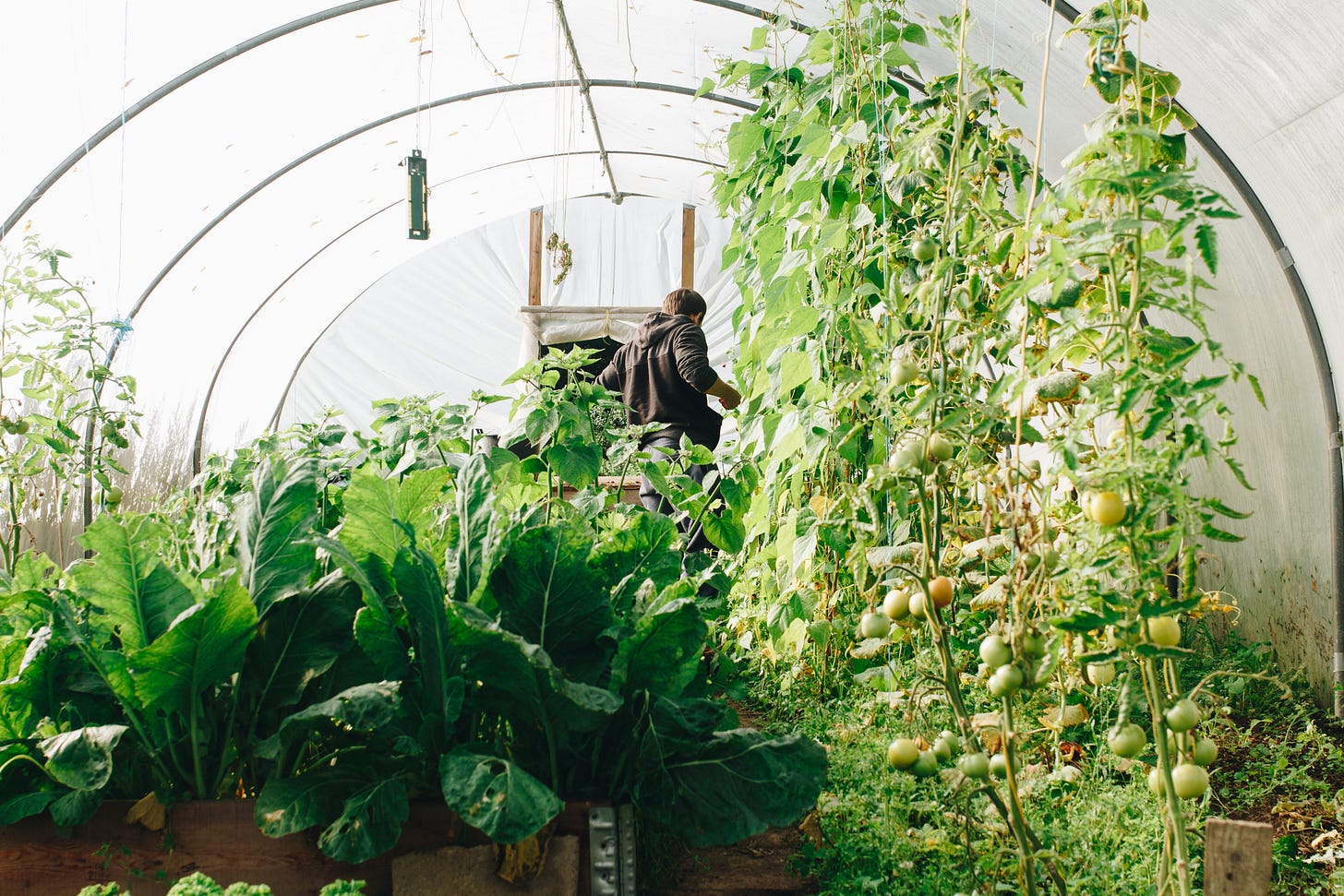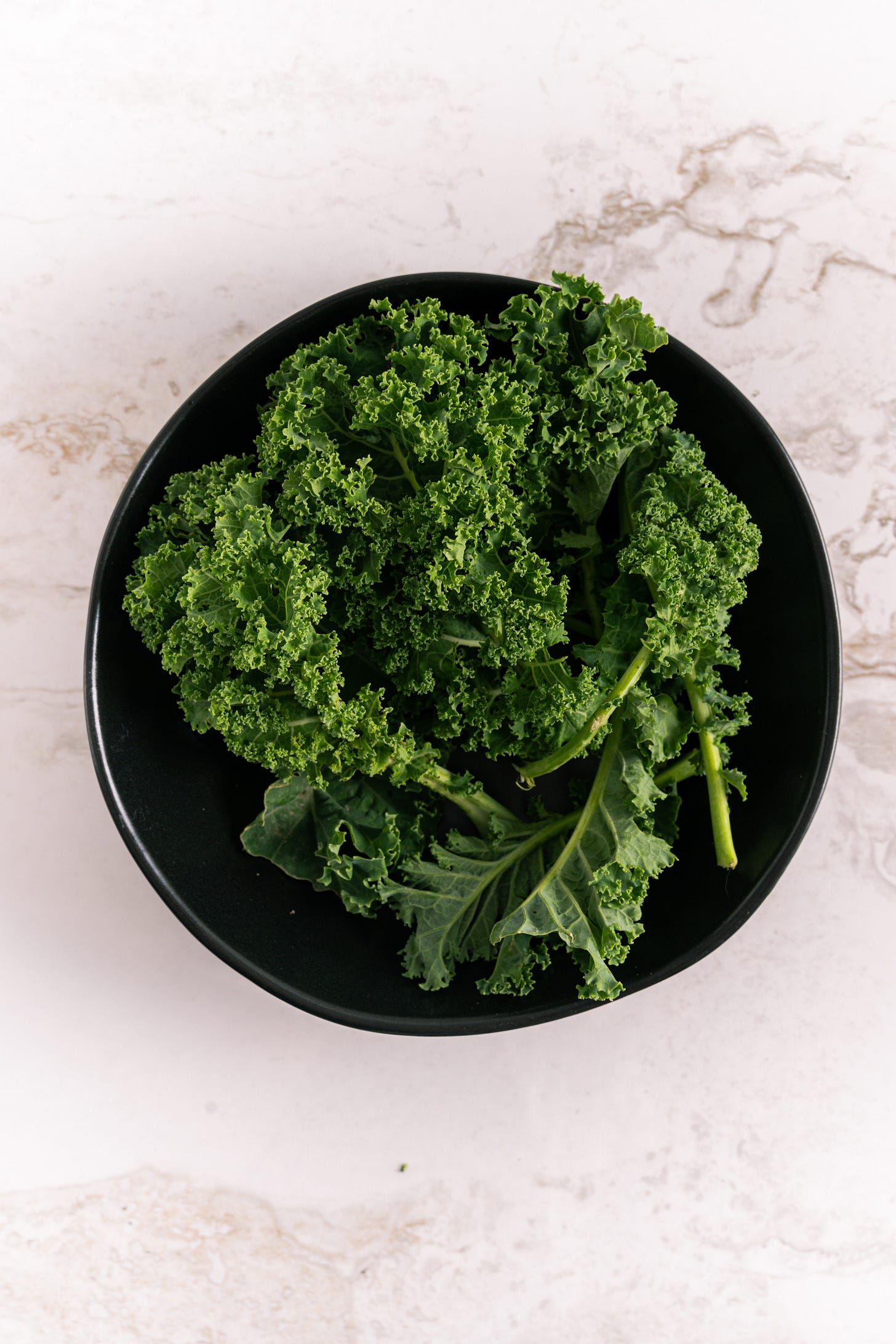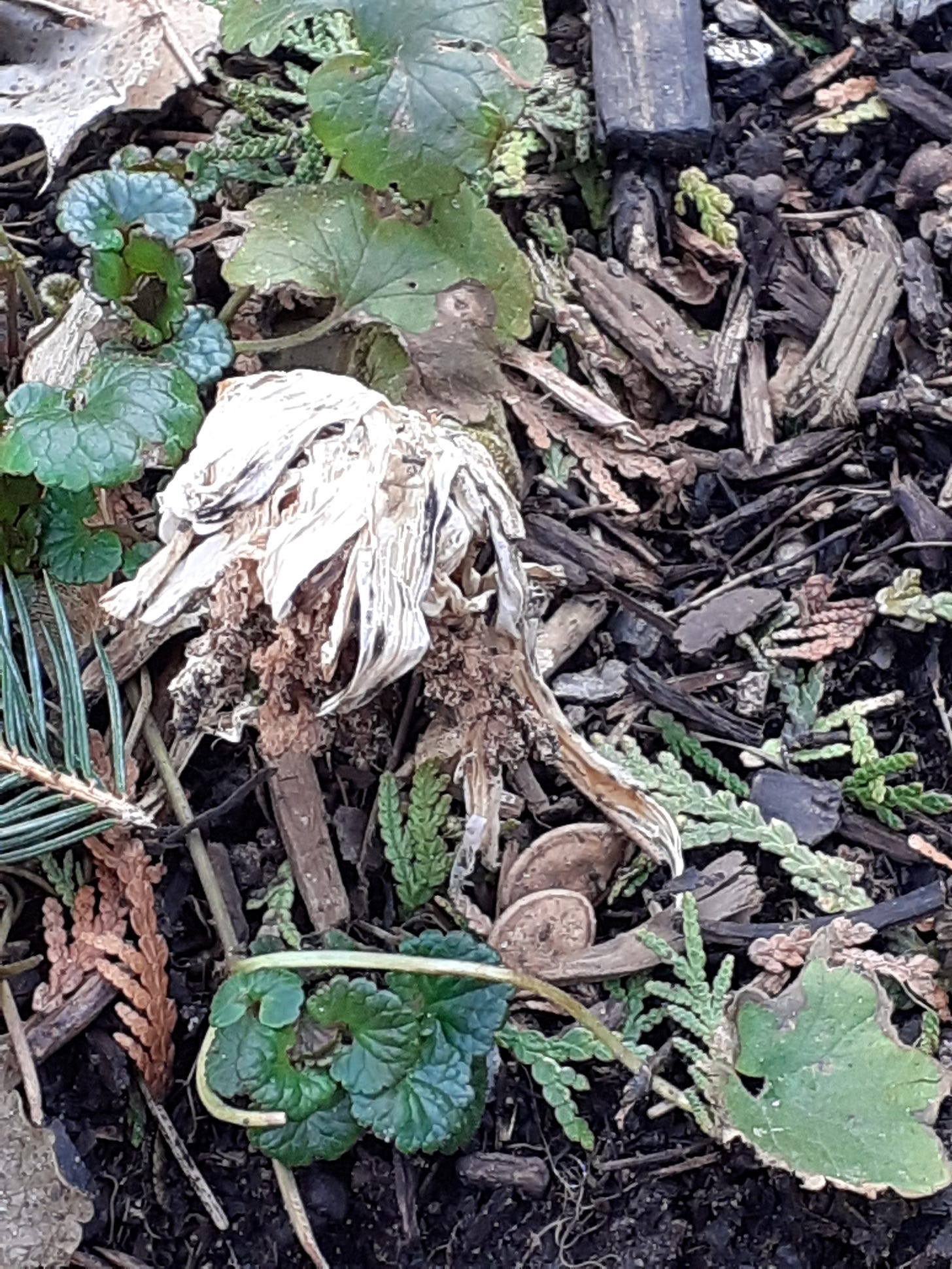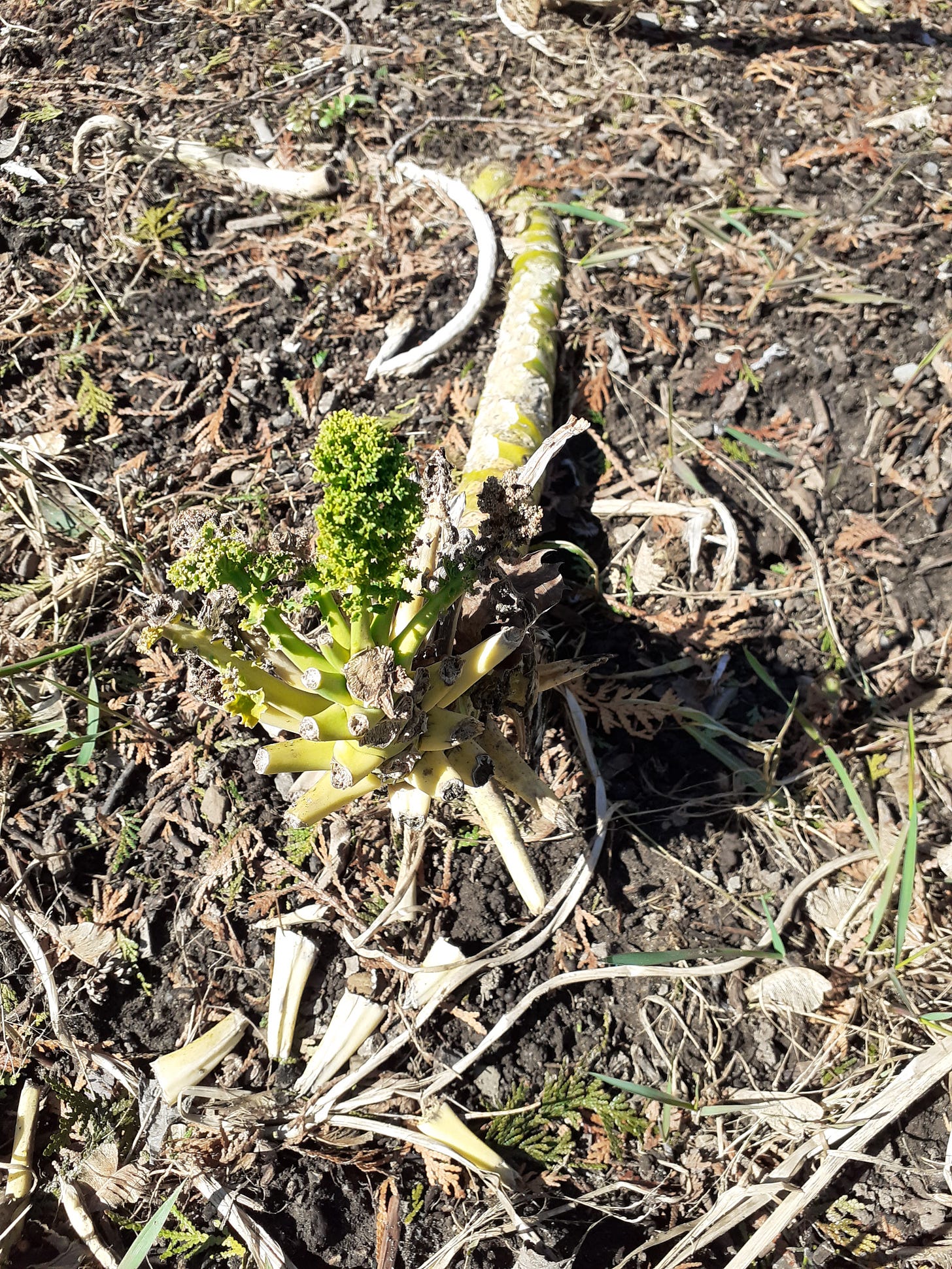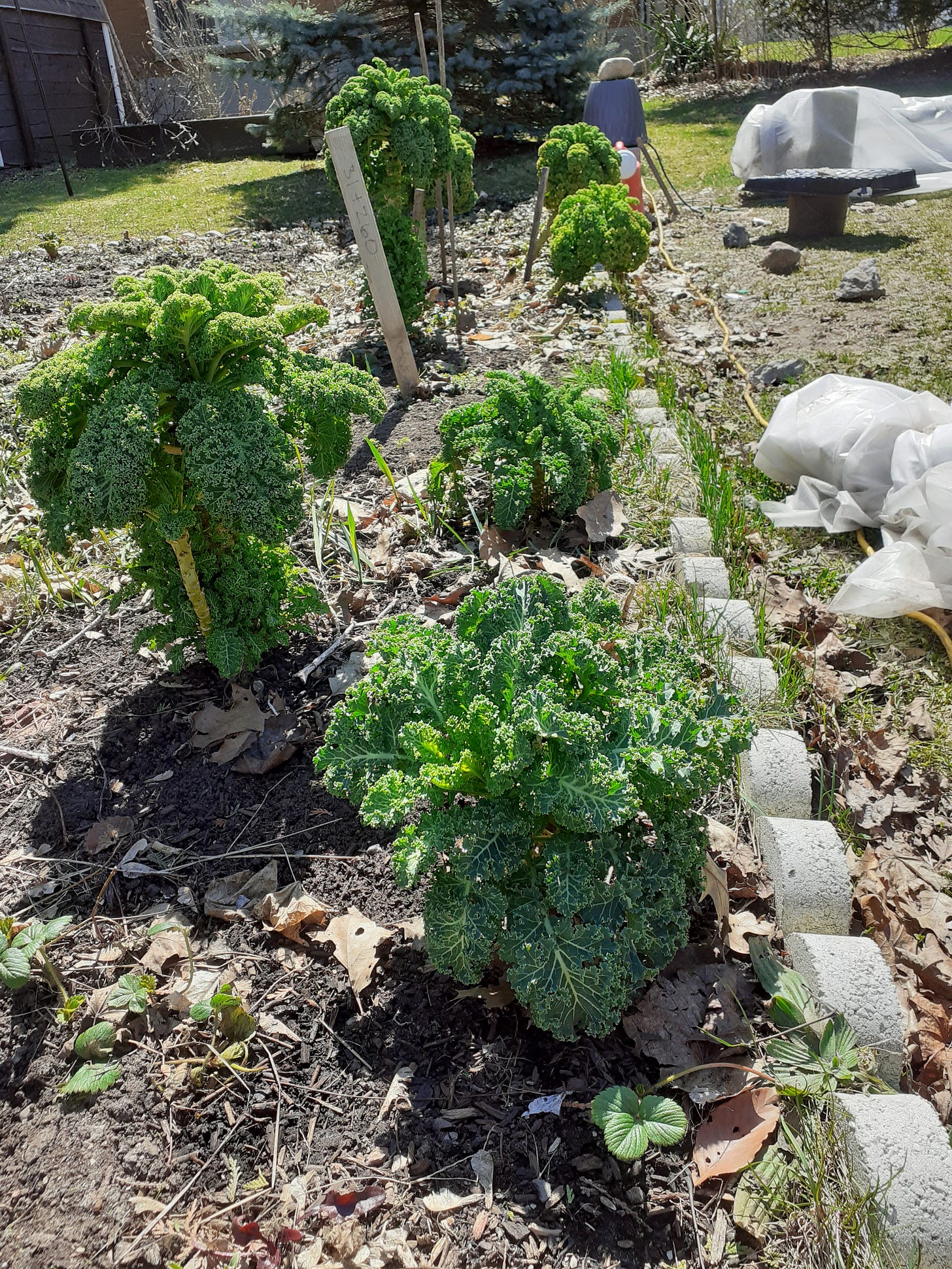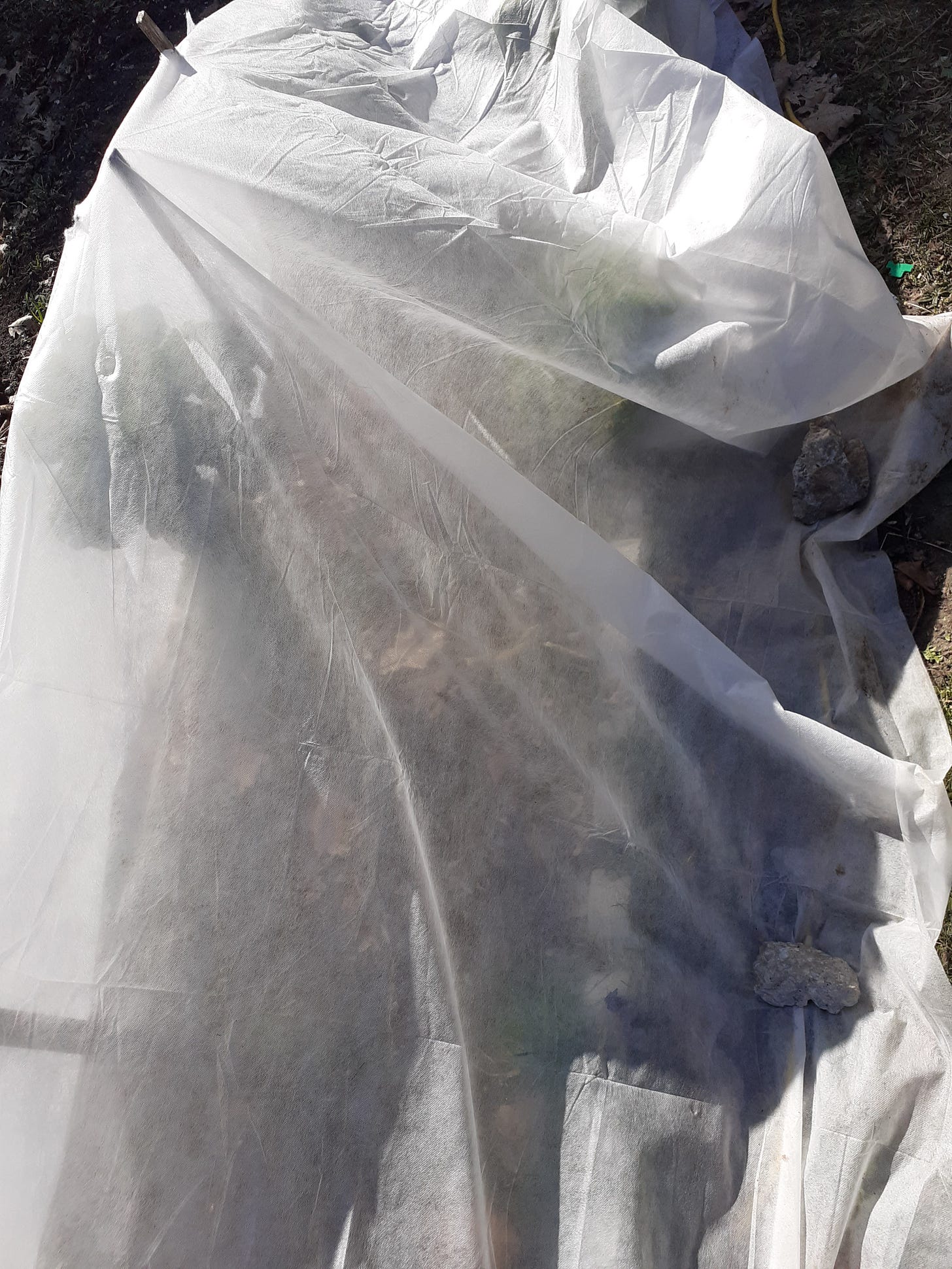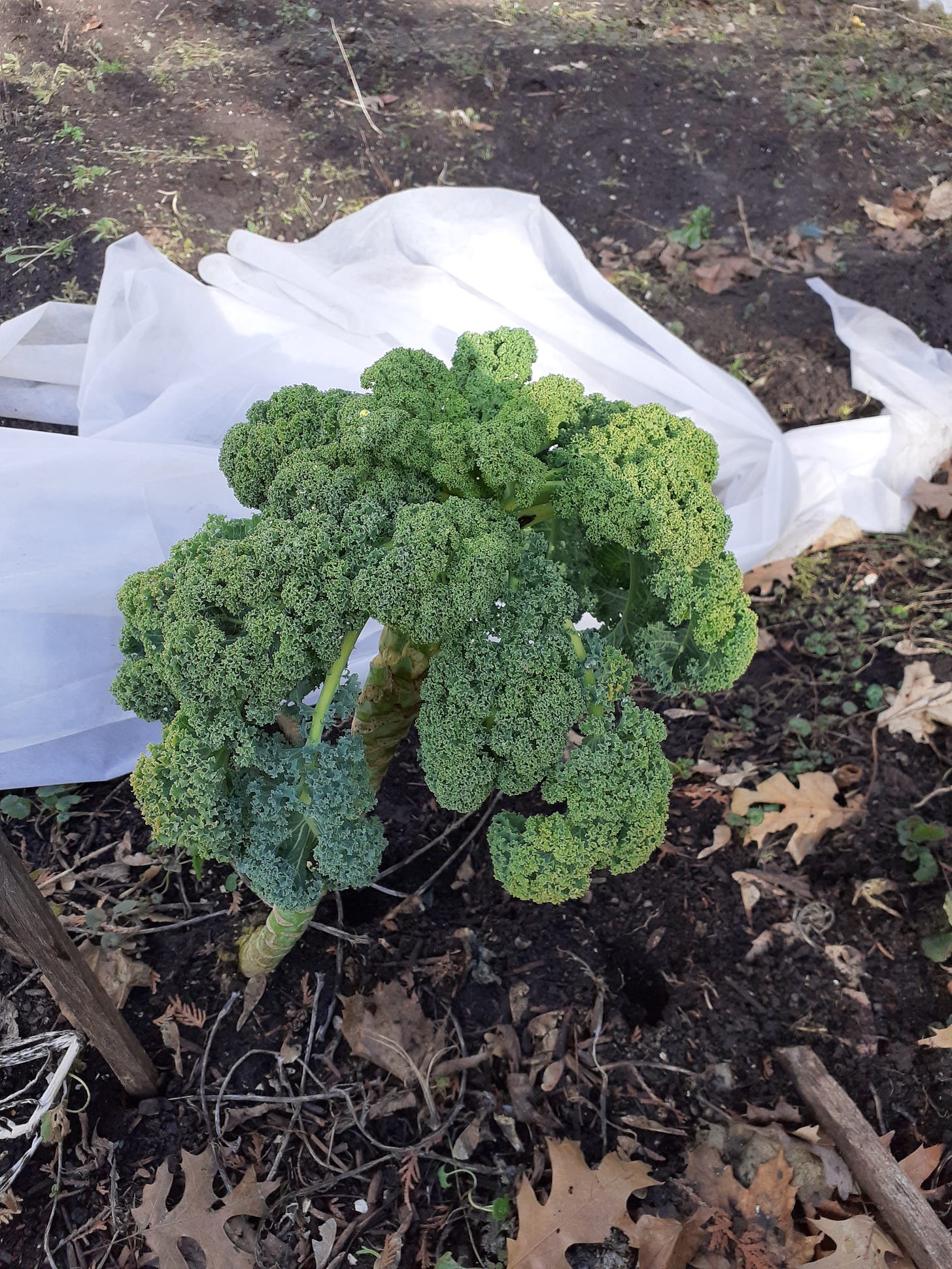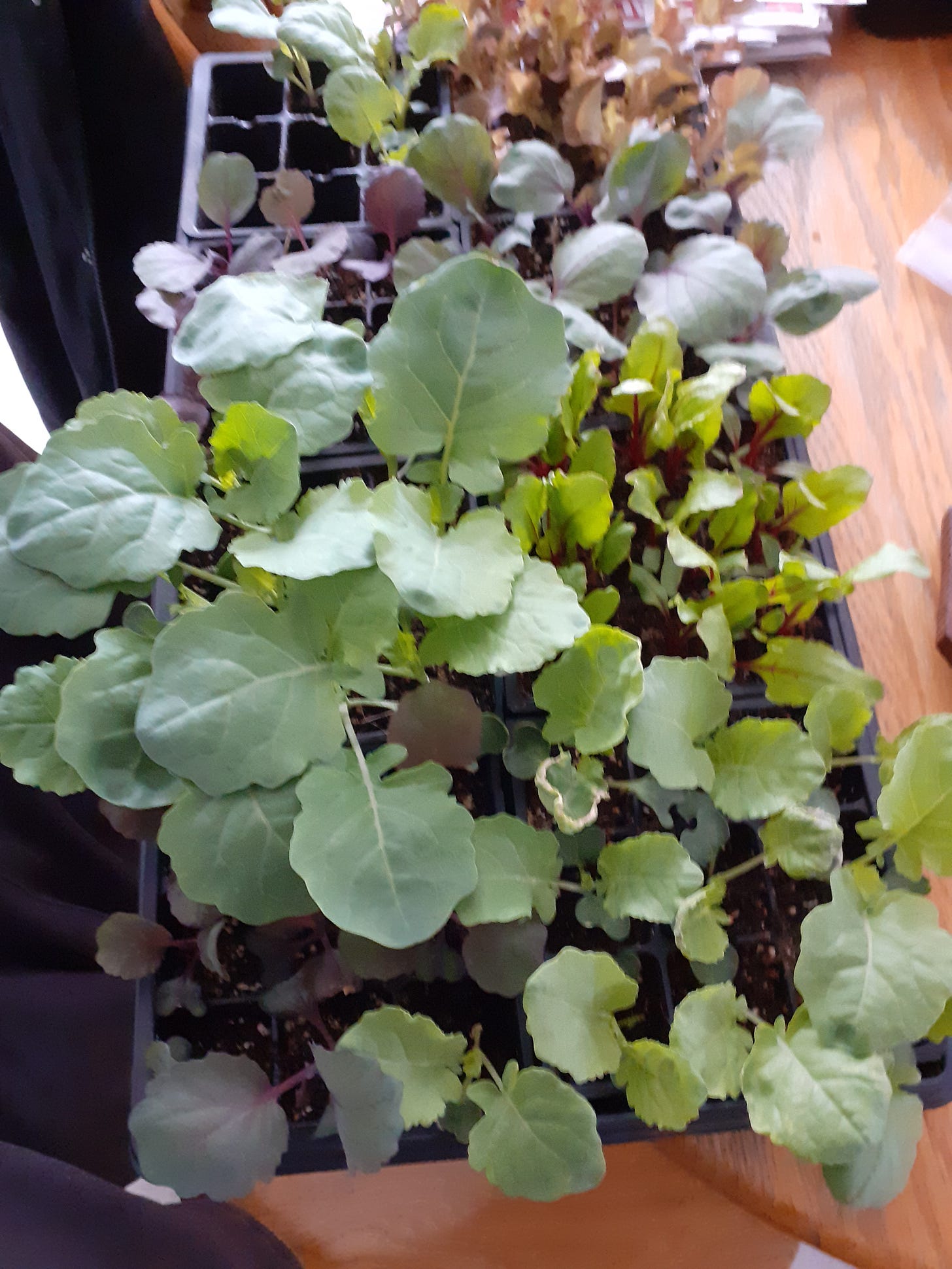Ever heard of season extension?
Season extension includes cultivation techniques that gardeners and farmers use to plant and harvest outside of the normal growing season to increase harvest yields.
It allows them to:
Start plants early and harvest early.
Start plants late and harvest late.
Imagine picking vegetables in December or having food in early spring.
Honestly, I always assumed this needed fancy equipment.
But this is the wrong kind of thought process. We need to stop thinking that technology can solve every problem. Solutions usually become apparent once problems are more understood. And that’s the trick with season extension.
Who are the proponents of season extension and what methods are normally used?
One of the most popular personalities on winter gardening is Eliot Coleman1. His book The Winter Harvest Handbook: Year Round Vegetable Production Using Deep-Organic Techniques and Unheated Greenhouses describes winter gardening’s history, key concepts and trial data to be successful with season extension.
These are a few key concepts:
Most vegetables do not grow during the winter, but are rather sustained.
(They technically do grow but very slowly due to heat and light limitations).Mature cold and frost tolerate species can survive the winter if protected.
(Species selection is key and they need to be fully matured or close to it).Each protective layer shifts temperatures roughly up 1.5 zones.
(Double covering moves covered area 3 USDA zones south).
Below is a lookup table describing how temperature affects plant growth.

I suggest purchasing his book and reading through it if you’re interested in winter gardening.
He has several YouTube videos as well.
Charles Dowding2 has a similar method using fleece coverings for early spring.
These are the most common methods and categories of season extension.
Organic Growers School Harvest Conference 2014 has more pictures, ideas and links to additional resources if you are interested.
“Cold” Greenhouse
Raises the temperature a few degrees above ambient temperatures and protects from wind, frost and heavy rain. Can be used for crops that can tolerate minor freezing.
Row covers.
(Fleece or layers of outer plastic and inner floating row covering).Cold frame.
(Glass or plastic lid on a slanted box).Caterpillar tunnel.
(Portable large multi-row covering).
“Cool” Greenhouse
Raises temperature several degrees above ambient temperature and protects from wind, frost and heavy rain. Required for hardy crops that cannot handle freezing.
Solar greenhouse.
(Capture sun’s heat via orientation and design).Thermal battery greenhouse.
(Store daytime heat in water or ceramic and release at night).Walipini.
(A deep trench is dug to extract heat from the earth and protect plants).High tunnel with small heater.
(Uses a small propane heater or wood stove to raise the temperature).
“Hot” Greenhouse
Raises temperature to spring / summer growing conditions and protects from wind, frost and heavy rain. Required for summer crops like tomatoes and cucumbers.
Building extended greenhouse.
(Attachment uses building heat and sun with some artificial lighting).Heated greenhouse.
(Inflated double plastic greenhouse with a furnace).
Overwintering chart
I ran a trial in my garden last year (2022) and selected a very hardy plant: kale.
Kale can survive low temperatures and is frost tolerant.
A curly or purple variety is preferred for overwintering.
Boutanical Interests has a list of vegetables that can be overwintered including the last sowing date3 and protection temperatures.
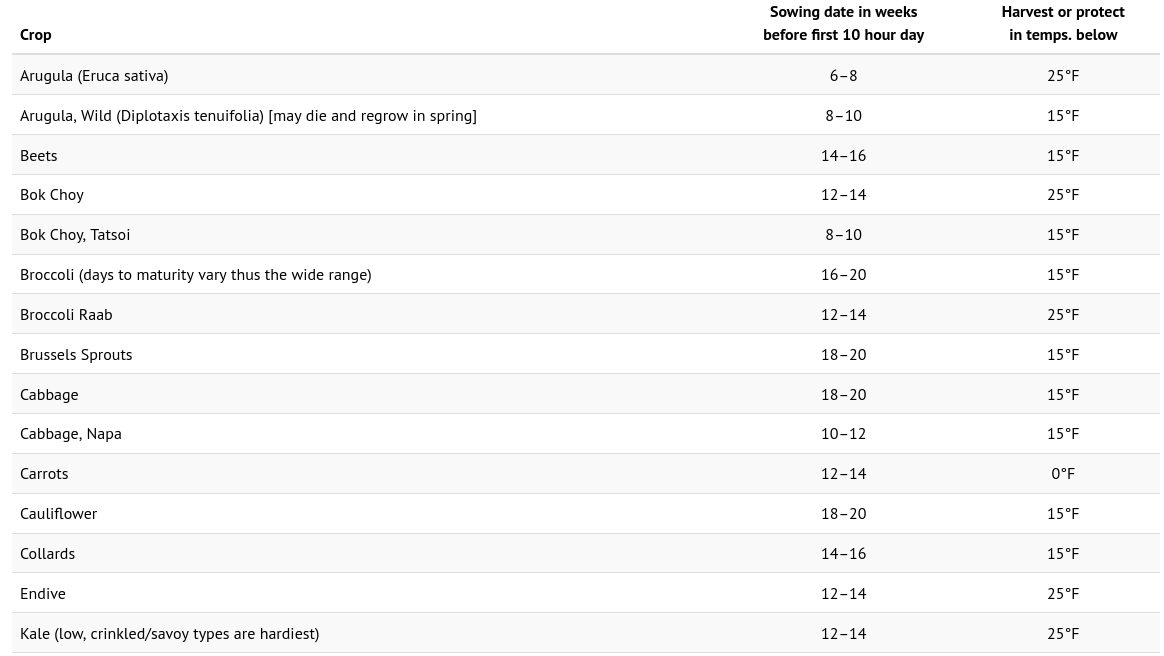
Overwintering trial
PLANT: I used a curly green heirloom variety of kale.
In principle, I should be able to seed save this variety and have a long-term supply of garden greens. Brassicas need about 20 plants to properly pollinate, which I did not do in this trial.
PROTECTION: I used garden fleece.
In the future I want to repeat using bed sheets from a thrift store and compare results.
Setup
LOCATION: Zone 5 Canada.
GERMINATION: March 2022.
PLANTED: April 2022.
(Transplants in garden).Row 1 was planted with protection.
Row 2 was planted with protection.
Select plants were planted without protection.
SETUP: Plants matured during 2022 and were periodically harvested for leaves.
OVERWINTERING METHOD: Plants were prepared for winter.
Row 1 was covered with protection.
(Wooden stakes kept cover off leaves).Row 2 was not covered.
Select plants were not covered.
Results
Row 1 survived winter.
(a.)Lower leaves were pruned in March 2023.
Some leaves touching cover were damaged.
Cover was left on until mid April 2023.
New growth leaves are edible.
Row 2 survived winter.
(b.)Rabbits ate many leaves in December.
All leaves were damaged by frost and snow.
Stem survived winter and is showing new growth.
New growth is not large enough to eat and would likely kill the plant.
Select plants did not survive winter.
(c.)These plants were weather damaged in spring 2022.
Plants recovered throughout the 2022 growing season.
Plants did not have enough stored energy to survive the winter.
(They may have also been eaten by a lurking rabbit...)
Other species were included for fun, but did not survive this setup:
Broccoli.
Beets.
Chard.
Select plants with no protection (c.)
In the very middle are the remains of a kale plant. Kale planted from direct sowing likely would not have this issue, but plants need help if transplanted early. This is a result of planting too early and not providing cover.
Row 2 (b.)
This plant was eaten by rabbits and significantly damaged by snow, but still has enough energy to initiate new growth. However, this is not enough green to use in the kitchen since the plant needs it to recover. It may be ready a little later before the plant prepares itself to bolt and enters its reproductive phase.
Row 1 (a.)
Covering was removed during April 2023. Plants are vibrant and green with plenty of new growth. Some plants (small ones) were cut at the stem during the 2022 growing season, but were able to regrow and store enough energy to survive winter.
Below is the covering on used on the row. Note that weight from the snow pierced through where the stakes were propping up the cover. This is not a good long-term design. Ideally plastic supported by a frame or sturdy hoops should be used instead.
During the winter, snow rolled off the top and accumulated along the sides of the cover. A good overwintering setup should be pitched at an angle to allow snow to fall to the side and not weigh down the cover.
This row was selected, because it gets the most sun during the winter months. That decision is a key factor when planning overwintered vegetables.
New growth is edible and ready for the kitchen. There were some onions, garlic and small carrots that also overwintered. These can be used anytime for meals while 2023 transplants mature in the garden.
This did not work for broccoli, beets and chard.
With the exception of broccoli, beets and chard are biennial and should have been able to make it through the winter, but this protection scheme appears to be insufficient. The varieties planted may not be a suitable biennial for this zone.
(More protection may be needed to overwinter these crops).
Species and variety is an important factor when selecting protection schemes.
I am really happy with the results of this trial. I have other experiments in mind for this year, which is why I like to get seeds started early and get successions ready.
This is my first round of transplants:
(Just transplanted outside under fleece cover).
Broccoli.
Cabbage.
Beets.
Lettuce.
This is what I currently have in the pipeline:
I have my next transplant succession4 growing.
(This includes ‘fillers’ like lettuce and beets as well as herbs and flowers).I germinated a summer crop succession.
I started a JADAM liquid fertilizer using compost, kitchen scraps and leaf mould.
I turned my compost pile made from fall plants, leaves and winter kitchen scraps.
Conclusion
These are great results!
For my next overwintering experiment I would like to try:
A semi-sunken south facing row.
(Minimizes wind convection and absorbs the highest amount of winter sun).A double plastic outer covering.
(Air gap between plastic adds thermal resistance).An inner floating row cover.
(Additional layer to reduce heat transfer).Heat sinks on the north side of the row.
(Buckets of water or JLF mixes painted flat black to radiate heat at night).A deep augered hole with a perforated tube.
(Passively exchange cold air with heat from the ground).A heavy leaf or straw mulch applied at the base of each plant.
(Acts as a moisture barrier, insulator and any decay releases heat).
I would like to trial two of these where I pull a canvas tarp over one at night and uncover it in the morning as part of a daily chore. In theory, this should limit radiated heat at night. Temperature readings would be recorded throughout this setup.
Overwintering described in my recent trial can easily be done by beginner gardeners, because the process is as simple as covering select hardy plants with a sheet before cold weather. Again, it would be interesting to try with a used bed sheet.
Overwintering closes the ‘hunger gap’ and inches us towards to a more local, low energy and sustainable food system. If you have never gardened then I suggest starting now. Growing plants at home is a lot cheaper than store bought vegetables.
Remember food prices are only going up…
Try planting something once a week or every two weeks.
I recommend planting a small amount of carrots, beets, lettuce5, radishes or green onions every week throughout the growing season. This ensures a continual baseline supply of vegetables and greens in conjunction with season specific harvests.
Get your hands dirty and let me know if you have any tips or more useful suggestions!
Eliot Coleman (born 1938) is an American farmer, author, agricultural researcher and educator.
Charles Dowding is an English horticulturalist and author.
Germination tends to be unpredictable, especially with heirloom varieties. I would read this as last transplant date.
Keep multiple successions going, because sometimes transplants die or get eaten, and having a replacement ready wastes less time. Keep the successions small but frequent.
Lettuce does not like summer heat, but can be replaced with beet tops, chard or a heat tolerant variety during these months. Let some lettuce plants bolt, because insects like the flowers and the seed is one of the easiest to save.


